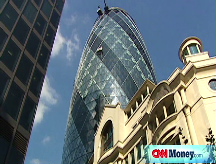2009: Nowhere to go but up
Stocks are expected to start the recovery process in 2009, but volatility will remain with a big question mark hanging over corporate health.
NEW YORK (CNNMoney.com) -- As stocks put their worst year ever behind them, 2009 will be the start of a very slow and very painful recovery.
Investors should brace for wild market swings as companies and the economy struggle to rebound. This past year was marred by horrid corporate results, record high oil and gas prices, dismal housing news and a full-blown shakeup on Wall Street.
"A fair amount of damage has been done, and earnings need to stabilize first," said Tobias Levkovich, chief investment strategist for Citigroup. "Before the patient gets better, let's make sure his condition doesn't worsen."
On many days, analysts predict markets could tumble on poor corporate earnings and sour economic news. But optimism about the new administration and apparent success of government interventions will help stocks skyrocket on other days.
That sounds just like 2008, which witnessed four of the five worst market days ever in the Dow Jones industrial average - but also the three largest increases.
2009 may be better, but stocks won't rise in a straight line to recovery. A majority of analysts expect that in the first months of the year, the S&P 500 index will test its 2008 low of 752, set on Nov. 20, even though the market has recovered more than 16% since then.
"The market could end up tracing out the [crooked] design on Charlie Brown's shirt," said Sam Stovall, chief investment strategist for Standard & Poor's. "There's no guarantee that the Nov. 20 low was the low for this bear market."
By the end of 2009, however, analysts expect anywhere from a 10% to a 25% improvement in the S&P 500 (SPX). Experts forecast the index finishing an average of 135 points higher to about 1,025 on Dec. 31, 2009.
The Dow (INDU) is expected to close up 900 points at about 9,500, and the Nasdaq composite index (COMP) is predicted to gain 160 points to close out 2009 at about 1,700.
President-elect Barack Obama's proposed stimulus plan and signs that the stranglehold on credit is loosening will likely be the early catalysts giving support to the markets, say analysts.
But any early rally will be on shaky ground as the economy continues to weaken.
Analysts expect GDP to fall anywhere from 1% to 3% in 2009, with declines of as much as 5% in the first half of the year before predicting a modest increase beginning in June as the country pulls out of what would be the longest recession in history.
In the second half of 2009, most analysts believe the market will begin to rise more consistently, as economic indicators start showing improvement in key areas of construction, housing, retail sales and credit.
"At some point after mid-2009, the tailwinds of lower gasoline, fiscal stimulus, housing stabilization, and even an auto sales recovery should generate a sustainable rally," said Thomas Lee, chief equities strategist for JPMorgan Chase.
In most years, anything in a 10% to 25% range would be a pretty good return to investors. But after the S&P 500 tanked 583 points over the course of 2008, stocks would need to rise 65% in 2009 just to get back to end-of-2007 levels.
According to Stovall, it might be a while before we see a full recovery: Historic "mega-meltdowns" of 40% or more have taken an average of five years to get back to the break-even point. In 2008, the S&P 500 has tumbled 41%.
After forecasts of a 15% to 20% decline in earnings per share for S&P 500 companies in 2008, analysts have mixed views on 2009.
Some expect corporate financial results to snap back in 2009. That will largely be helped by the financial and consumer discretionary sectors - both took a beating in 2008 on large writedowns and record declines in consumer spending and confidence.
"S&P analysts aren't expecting a miraculous recovery in earnings in the midst of a severe recession," said Stovall. "But they do see comps, or year-over-year comparable results, beginning to improve during the second half of the year."
However, others say 2009 will represent the trough for earnings, sinking on low capacity utilization, a stronger dollar that will hurt foreign profits, continued writedowns and a possible deflationary period.
That puts forecasts for 2009 anywhere from a decline of 18% to an increase of 26%.
Standard & Poor's was on the high end of that range. But excluding an expected gain for financial sector and consumer discretionary sector earnings , S&P analysts said they expect overall earnings to rise just 1.5%.
JPMorgan Chase also expects the financial sector earnings to return to positive territory, while Goldman Sachs and Morgan Stanley expect flat financial earnings. ![]()






